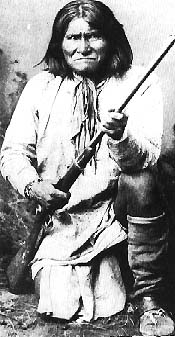The Frontier West

Geronimo, Apache leader (1829-1909)

B. Conflict with settlers in the East before the Civil War resulted in the removal policy which placed Indians in the trans-Mississippi west, most in Oklahoma territory.
C. Peace Commissions (army and Indian agents) sent to meet with Plains Indians in 1867 and 1868 and promised aid and non-interference
D. Conflicts between Indians and U.S. Army
2. Little Big Horn-1876. Gen. Custer and 264 troops killed by Sioux Indians in Montana Territory.
3. Chief Joseph and Nez Perce captured by army after 1300 mile chase
4. Wounded Knee-1890. 200 unarmed Sioux killed after Sitting Bull was killed.
2. Tribal loyalties had to be renounced to gain American citizenship
3. Between 1887 and 1934, Indians lost over half of their reservation lands to whites
2. Silver discovered in Virginia City, Nevada (Comstock Lode)
2. Texas longhorns brought in herds of 3000 cattle from Texas to railhead towns such as Abilene and Dodge City
2. Barbed wire (invented by Joseph Glidden) allowed farmers to fence range land to keep cattle from grazing
B. Homestead Act (1862) brought settlers to west from East and Europe (basically free land of 160-acre sections)
C. Railroads established towns, sold land after huge land grants from the government
D. Last major section of the west settled with Oklahoma Land Rush of 1889.
B. Frederick Jackson Turner's thesis ("The Frontier in American History") stated
2. Self-reliance and independent nature of American culture were fostered by the frontier
 Back
to Outlines & Charts Index
Back
to Outlines & Charts Index
 Back
to U.S. History Resources main
page.
Back
to U.S. History Resources main
page.